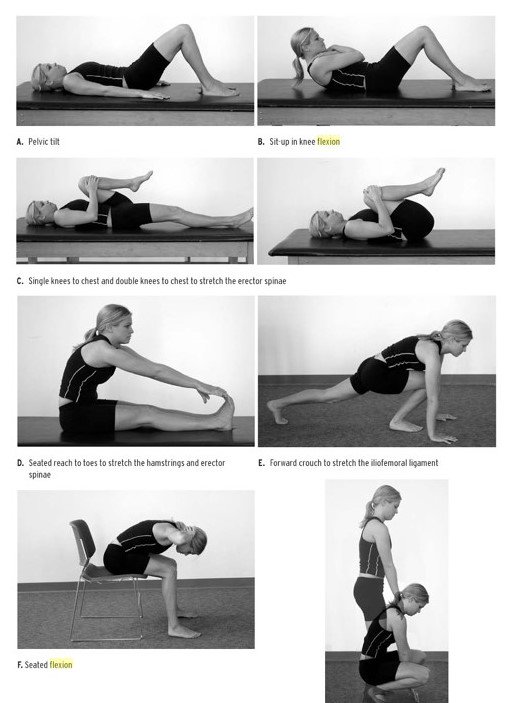Enhance your health with free online physiotherapy exercise lessons and videos about various disease and health condition
Williams Flexion Exercises
Williams flexion exercises focus on placing the lumbar spine in a flexed position to reduce excessive lumbar lordotic stresses. Exercises are designed to (1) strengthen the abdominal, gluteal, and quadriceps muscles, and (2) stretch the erector spinae, hamstring, and tensor fasciae latae muscles and iliofemoral ligament.
INTRODUCTION
Williams flexion exercises — also called Williams lumbar flexion exercises, Lumbar flexion exercises or simply Williams exercises — are a set or system of related physical exercises intended to enhance lumbar flexion, avoid lumbar extension, and strengthen the abdominal and gluteal musculature in an effort to manage low back pain non-surgically. The system was first devised in 1937 by Dr. Paul C. Williams (1900-1978), then a Dallas orthopedic surgeon.
RATIONALE
Williams believed that the basic cause of all pain is the stress induced on the inter-vertebral disc by poor posture. He theorized that the lordotic lumbar spine placed inordinate strain on the posterior elements of the inter-vertebral disc and caused its premature dysfunction. He was concerned about the lack of flexion in daily activities in the accumulation of extension forces that hurt the disc.
GOALS OF WILLIAMS FLEXION EXERCISES
The goals of these exercises are to open the intravertebral foramina and stretch the back extensors, hip flexors, and facets; to strengthen the abdominal and gluteal muscles; and to mobilize the lumbosacral junctions.
CORE EXERCISES
Williams believed that the back pain was the result of human evolution in movement from a quadruped to an upright position, proposing that the standing position was the cause of back pain because it placed the low back in a lordotic curve. Williams advocated seven exercises to minimize the lumbar curve-
pelvic tilt exercises, partial sit-ups, single knee-to-chest and bilateral knee-to-chest, hamstring stretching, standing lunges, seated trunk flexion, and full squats.
 Williams flexion exercises- Source Athletic Training and Sports Medicine
By Chad Starkey, Glen Johnson
Williams flexion exercises- Source Athletic Training and Sports Medicine
By Chad Starkey, Glen Johnson1- Pelvic tilt exercises:
Lie on your back with knees bent, feet flat on floor. Flatten the small of your back against the floor, without pushing down with the legs. Hold for 5 to 10 seconds.
2- Partial sit-ups:
The athlete lies in "hooklying" position (supine with knes bent and feet flat). With hands behind his or her head, the athlete elevates the upper torso until the scapulae clear the resting surface and stress is placed on the rectus abdominus. After returning to the start position, the sit-up is repeated for a prescribed number of repitions.
3- Knee-to-chest:
Single Knee to chest. Lie on your back with knees bent and feet flat on the floor. Slowly pull your right knee toward your shoulder and hold 5 to 10 seconds. Lower the knee and repeat with the other knee.
Double knee to chest. Begin as in the previous exercise. After pulling right knee to chest, pull left knee to chest and hold both knees for 5 to 10 seconds. Slowly lower one leg at a time.
4- Hamstring stretch:
Lying supine, the athlete places both hands around the back of one knee. The athlete straightens his or her knee and pulls the thigh toward his or her head so the hip goes into flexion. Williams believed that flexible hamstrings are necessary to accomplish full flexion of the lumbar spine. Although tight hamstrings limit lumbar flexion in standing with knee straight, we now know that tight hamstrings actually tilt the pelvis posteriorly and promote trunk flexion.
5- Standing lunges:
This exercise actually results in some extension of the lumbar spine when performed properly. Nonetheless, it is a good stretching exercise for the entire lower extremity, especially the iliopsoas, which may be a perpetrator of low back pain if it is abnormally tight or in spasm.
The athlete begins the forward lunge in a standing position with the feet shoulder width apart. He or she then takes a big step forward with the right leg and plants the foot out front, keeping the body relatively straight. The knee should stay over your ankle and not extend out over the toes to minimize stress on the knee joint.
6- Seated trunk flexion:
This exercise is performed by sitting in a chair and flexing forward in a slumped position. Maximum trunk flexion is obtained and direct stretching of the lumbosacral soft tissue structures occurs.
7- Full squat:
William's squat position is with the feet placed shoulder width apart, the hip and knees are flexed to the maximum available range of motion, and the lumbar spine is rounded into flexion. Upon reaching maximum depth, the athlete "bounces the buttocks up and down" 15 to 20 times, with 2 to 3 inches of excursion on each bounce, then repeats 3 to 4 times.
In modern era Williams flexion exercises are specifically used in medical conditions like Spinal Stenosis, Spondylolisthesis, and facetal locking where spinal extension is painful.
For years, the Williams Flexion Exercises were the main stay of most low back pain prevention and care programs. They certainly accomplished the goal of flattening the lumbar spine and were advocated by physical therapists who worked with sports and industrial injuries. Although the success was limited, William's comprehensive program helped advance the idea that strong abdominal muscles are needed to prevent low back pain and improve core strength.
References For Williams Flexion Exercises
- Therapeutic Exercise for Musculoskeletal Injuries 4th Edition By Houglum, Peggy A.
- Athletic Training and Sports Medicine By Chad Starkey, Glen Johnson
- Clinical Decisions in Therapeutic Exercises , Planning and Implementation ... By CTI Reviews
- Orthopaedic Physical Therapy Secrets - E-Book By Jeffrey D. Placzek, David A. Boyce
- The Shoulder and the Overhead Athlete edited by Sumant G. Krishnan, Richard J. Hawkins, Russell F. Warren
- https://en.wikipedia.org/wiki/Williams_Flexion_Exercises
Back to Home Page
Recent Articles
|
Author's Pick
Rating: 4.4 Votes: 252 |

